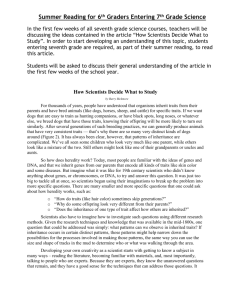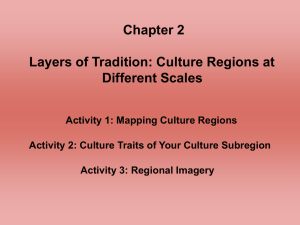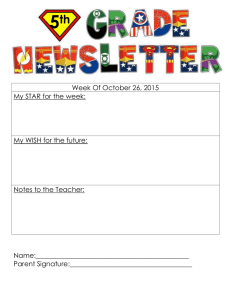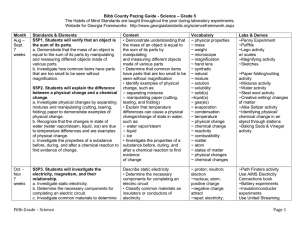Curriculum Map Science – Grade 5 The Habits of Mind standards
advertisement
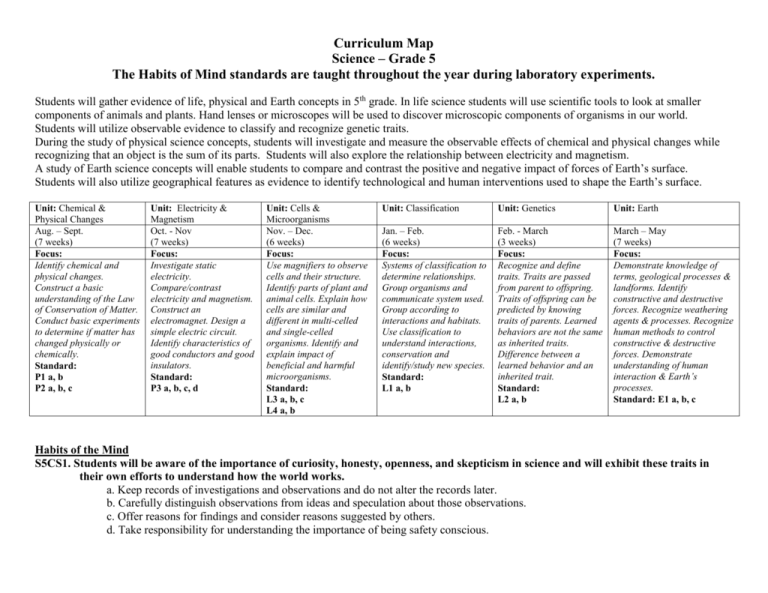
Curriculum Map Science – Grade 5 The Habits of Mind standards are taught throughout the year during laboratory experiments. Students will gather evidence of life, physical and Earth concepts in 5th grade. In life science students will use scientific tools to look at smaller components of animals and plants. Hand lenses or microscopes will be used to discover microscopic components of organisms in our world. Students will utilize observable evidence to classify and recognize genetic traits. During the study of physical science concepts, students will investigate and measure the observable effects of chemical and physical changes while recognizing that an object is the sum of its parts. Students will also explore the relationship between electricity and magnetism. A study of Earth science concepts will enable students to compare and contrast the positive and negative impact of forces of Earth’s surface. Students will also utilize geographical features as evidence to identify technological and human interventions used to shape the Earth’s surface. Unit: Chemical & Physical Changes Aug. – Sept. (7 weeks) Focus: Identify chemical and physical changes. Construct a basic understanding of the Law of Conservation of Matter. Conduct basic experiments to determine if matter has changed physically or chemically. Standard: P1 a, b P2 a, b, c Unit: Electricity & Magnetism Oct. - Nov (7 weeks) Focus: Investigate static electricity. Compare/contrast electricity and magnetism. Construct an electromagnet. Design a simple electric circuit. Identify characteristics of good conductors and good insulators. Standard: P3 a, b, c, d Unit: Cells & Microorganisms Nov. – Dec. (6 weeks) Focus: Use magnifiers to observe cells and their structure. Identify parts of plant and animal cells. Explain how cells are similar and different in multi-celled and single-celled organisms. Identify and explain impact of beneficial and harmful microorganisms. Standard: L3 a, b, c L4 a, b Unit: Classification Unit: Genetics Unit: Earth Jan. – Feb. (6 weeks) Focus: Systems of classification to determine relationships. Group organisms and communicate system used. Group according to interactions and habitats. Use classification to understand interactions, conservation and identify/study new species. Standard: L1 a, b Feb. - March (3 weeks) Focus: Recognize and define traits. Traits are passed from parent to offspring. Traits of offspring can be predicted by knowing traits of parents. Learned behaviors are not the same as inherited traits. Difference between a learned behavior and an inherited trait. Standard: L2 a, b March – May (7 weeks) Focus: Demonstrate knowledge of terms, geological processes & landforms. Identify constructive and destructive forces. Recognize weathering agents & processes. Recognize human methods to control constructive & destructive forces. Demonstrate understanding of human interaction & Earth’s processes. Standard: E1 a, b, c Habits of the Mind S5CS1. Students will be aware of the importance of curiosity, honesty, openness, and skepticism in science and will exhibit these traits in their own efforts to understand how the world works. a. Keep records of investigations and observations and do not alter the records later. b. Carefully distinguish observations from ideas and speculation about those observations. c. Offer reasons for findings and consider reasons suggested by others. d. Take responsibility for understanding the importance of being safety conscious. S5CS2. Students will have the computation and estimation skills necessary for analyzing data and following scientific explanations. a. Add, subtract, multiply, and divide whole numbers mentally, on paper, and with a calculator. b. Use fractions and decimals, and translate between decimals and commonly encountered fractions – halves, thirds, fourths, fifths, tenths, and hundredths (but not sixths, sevenths, and so on) – in scientific calculations. c. Judge whether measurements and computations of quantities, such as length, area, volume, weight, or time, are reasonable answers to scientific problems by comparing them to typical values. S5CS3. Students will use tools and instruments for observing, measuring, and manipulating objects in scientific activities. a. Choose appropriate common materials for making simple mechanical constructions and repairing things. b. Measure and mix dry and liquid materials in prescribed amounts, exercising reasonable safety. c. Use computers, cameras and recording devices for capturing information. d. Identify and practice accepted safety procedures in manipulating science materials and equipment. S5CS4. Students will use ideas of system, model, change, and scale in exploring scientific and technological matters. a. Observe and describe how parts influence one another in things with many parts. b. Use geometric figures, number sequences, graphs, diagrams, sketches, number lines, maps, and stories to represent corresponding features of objects, events, and processes in the real world. Identify ways in which the representations do not match their original counterparts. c. Identify patterns of change in things—such as steady, repetitive, or irregular change—using records, tables, or graphs of measurements where appropriate. d. Identify the biggest and the smallest possible values of something. S5CS5. Students will communicate scientific ideas and activities clearly. a. Write instructions that others can follow in carrying out a scientific procedure. b. Make sketches to aid in explaining scientific procedures or ideas. c. Use numerical data in describing and comparing objects and events. d. Locate scientific information in reference books, back issues of newspapers and magazines, CD-ROMs, and computer databases. S5CS6. Students will question scientific claims and arguments effectively. a. Support statements with facts found in books, articles, and databases, and identify the sources used. b. Identify when comparisons might not be fair because some conditions are different. The Nature of Science S5CS7. Students will be familiar with the character of scientific knowledge and how it is achieved. Students will recognize that: a. Similar scientific investigations seldom produce exactly the same results, which may differ due to unexpected differences in whatever is being investigated, unrecognized differences in the methods or circumstances of the investigation, or observational uncertainties. b. Some scientific knowledge is very old and yet is still applicable today. S5CS8. Students will understand important features of the process of scientific inquiry. Students will apply the following to inquiry learning practices: a. Scientific investigations may take many different forms, including observing what things are like or what is happening somewhere, collecting specimens for analysis, and doing experiments. b. Clear and active communication is an essential part of doing science. It enables scientists to inform others about their work, expose their ideas to criticism by other scientists, and stay informed about scientific discoveries around the world. c. Scientists use technology to increase their power to observe things and to measure and compare things accurately. d. Science involves many different kinds of work and engages men and women of all ages and backgrounds.





